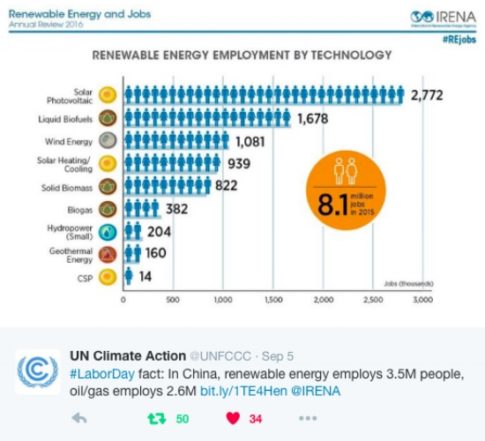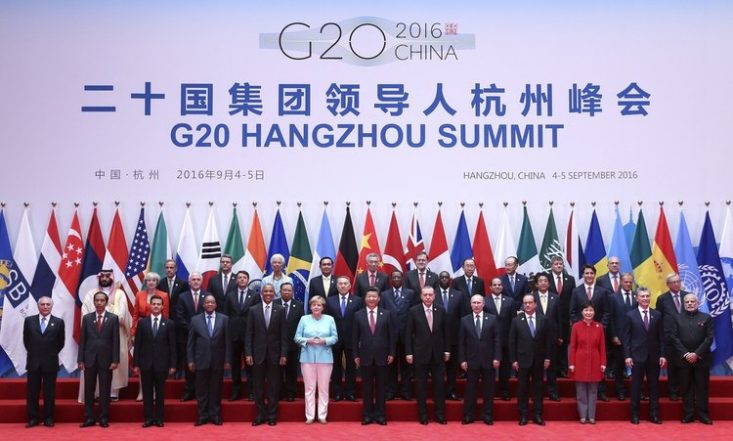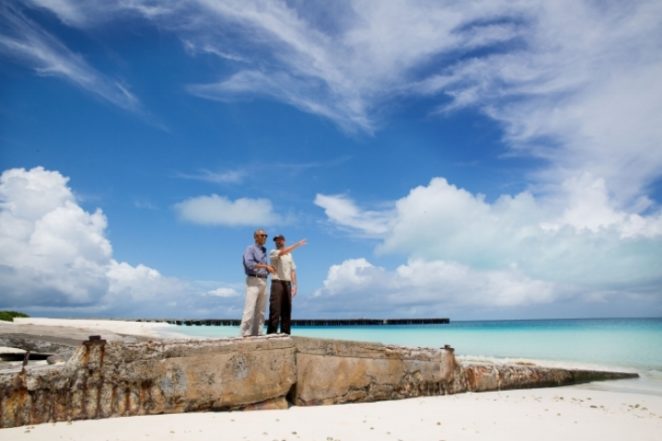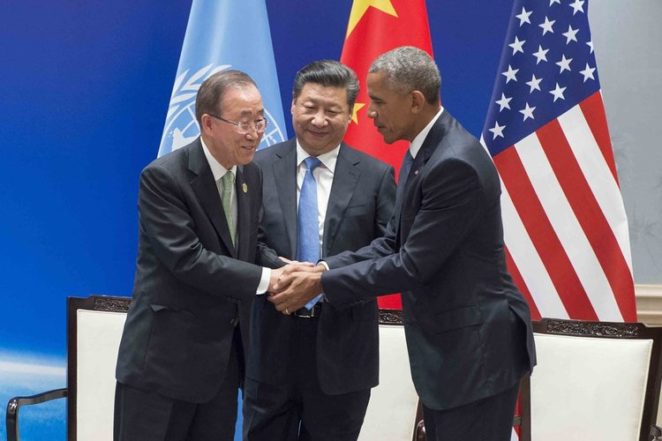On board: UN Secretary General Ban Ki-moon (left) congratulates Presidents Obama and Xi for making good on Paris.
- Paris Agreement needs ratification by 55 nations representing 55% of global carbon emissions;
- Official commitments from U.S. and China, alone, account for over 40% of worldwide emissions;
- China says it will soon start spending $600 billion per year on environmental projects;
- Mayors of 30+ mega-cities encouraged G20 Summit attendees to act boldly to reduce CO2.

As students of history know, the joy surrounding the signing of any important international agreement is meaningless if the signatory states don’t follow through and ratify the deal when they get home.
Less than a century ago, the most tragic example of this occurred when the U.S. Senate failed to ratify the Treaty of Versailles, dooming the fledgling League of Nations, and helping to plant the seeds for the catastrophe of World War II. Last week in Hangzhou, China, on the eve of the G20 Economic Summit, and with the 15th anniversary of 9/11 just days away, the world’s two biggest polluters jointly took concrete steps to avert future climate catastrophe.
On Sept. 3, China’s President Xi Jinping and U.S. President Barack Obama both presented United Nations Secretary-General Ban Ki-moon with their nation’s respective signed ratifications of the historic Paris Agreement. That landmark pact, signed last December in Paris by 195 countries — all parties to the UN Framework Convention on Climate Change (UNFCCC) — concluded two weeks of negotiation at the UN 21st Conference of Parties (COP21) and included a deadline for its enactment.
In order for the agreement to take effect, at least 55 countries representing at least 55% of all global emissions must take that next step. Combined, the U.S. and China account for more than 40% of that total. All told, with their addition, 26 countries now have formally ratified the accord.
“ As the world’s two largest economies and two largest emitters, our entrance into this agreement continues the momentum of Paris, and should give the rest of the world confidence that a low-carbon future is where the world is heading”
Meanwhile, more than 50 other countries also have either joined or publicly committed to work toward joining the agreement before the end of this year. Said President Obama, “We are here together because we believe that for all the challenges that we face, the growing threat of climate change could define the contours of this century more dramatically than any other challenge.”


For its part, China’s State Council approved guidelines for a new national strategy for “ecological civilization” that even includes “greening” its financial sector. The world’s most populous nation says it will soon start spending some $600 billion (USD) per year on green projects like environmental remediation and protection, renewables, energy efficiency, and green transportation. But less than 15% of this total will come from government sources, in accordance with President Xi’s desire to encourage private investment. Gov. Zhou Xiaochuan of the People’s Bank of China, said: “This commitment… reinforces [our] country’s ambition both to reshape its domestic financial system and to serve the needs of green inclusive development. We hope this will encourage other nations to do likewise.”
Cities Urge Support

Within those other nations, cities already are driving change. In an Open Letter to the G20 Leaders, posted Sept. 1 by the C40 Cities Climate Leadership Group, 30 big city mayors from around the world sent encouragement to Hangzhou: “To limit the global temperature increase to 1.5 degrees Celsius above pre-industrial levels, global green-house gas emissions need to peak by 2020. Achieving such a rapid shift is probably one of the greatest political, economic and practical challenges faced by every national leader, but you do have great allies in this task: we, the mayors of the mega-cities of the world.”
Signers included Rio de Janeiro’s Eduardo Paes (C40 Chair); Paris’s Anne Hidalgo; NYC’s Bill de Blasio; LA’s Eric Garcetti; Chicago’s Rahm Emanuel; London’s Sadiq Khan; and Tokyo’s Yuriko Koike. For the full list, as well as the complete letter, click here. An excerpt:
- As mayors, we are already dealing with the consequences of climate change on our cities, from floods to heat waves, and from water shortages to air pollution. Yet, we know that cities are a key part of the climate solution. From the rollout of fleets of electric buses in Chinese cities; the moves by European, South American and Indian cities to ban the most polluting cars from city centers; the retrofitting of tens of thousands of buildings across North American cities to deliver greater energy efficiency and dedicated low-carbon districts in cities worldwide, we are taking bold actions to cut emissions and prepare for the worst effects of a warming planet. In Paris, we collectively committed to deliver up to 3.7 gigatons of greenhouse gas emissions reductions annually by 2030.


To read the official joint statement, U.S.-China Climate Change Cooperation Outcomes, click here.


Discussion
Be the first to leave a comment.
You must be a member of the BuiltWorlds community to join the discussion.